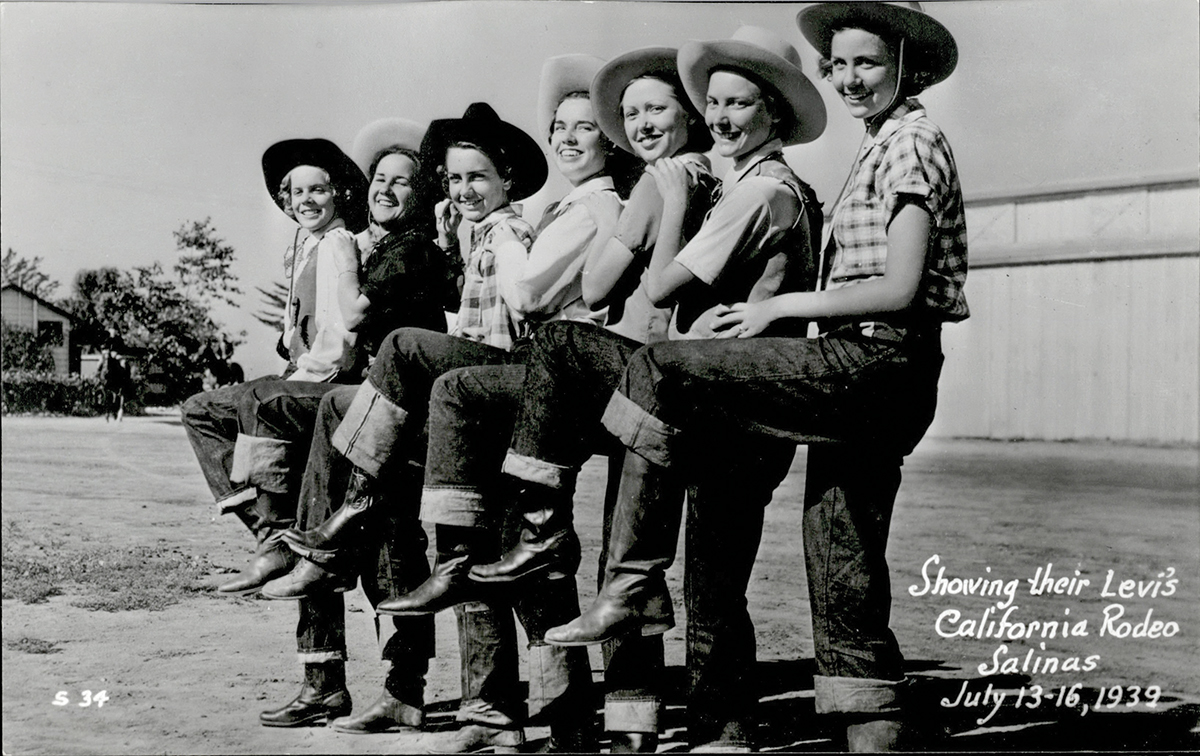A new retrospective honors the enduring legacy of San Francisco’s world-famous jeans
Words by CATHERINE BIGELOW
Pioneering blue jean king Levi Strauss never knowingly set his cap on defining the indigo-dyed cloth market. A Jewish immigrant from Bavaria, Germany, his “dry goods” merchant family decamped to New York to escape the 1848 European revolutions that toppled monarchies and engulfed a cacophony of small kingdoms and nation-states in economic chaos and religious discrimination.
But timing is, they say, everything. Strauss’ unintended fashion empire unfolded when the newly minted citizen struck out for the wild West Coast amid the California gold rush, a rare geological phenomenon which lured hundreds of thousands of immigrants seeking to strike it rich in the rugged Sierra Nevada terrain. That brief yet impactful span of time ignited a frenzy of global trade, greed and civic growth, which included the development of the transcontinental railroad and an accumulation of unmitigated riches for some of the “huddled masses yearning to breathe free,” as Emma Lazarus described those emigrating to the United States in her poem “The New Colossus,” inscribed on a plaque at the Statue of Liberty.
But Strauss, already a savvy merchant, realized the real gold could be mined by selling supplies (blankets, pickaxes, durable pants) to fortune hunters. So he stayed put in San Francisco, where, in 1873, he launched Levi Strauss & Co. with his patented pants.
In February, The Contemporary Jewish Museum debuts “Levi Strauss: A History of American Style” — the most comprehensive exhibition to date of this humble, working man’s uniform that developed into a billion-dollar, born-in-S.F. fashion empire.
“This exhibition captures the essence of The CJM’s mission, telling a story that is definitively Jewish, classically American and deeply embedded in the cultural fabric of San Francisco,” explains museum executive director Lori Starr. “In celebrating the birth of the blue jean, this exhibition shares the story of a hardworking Jewish immigrant who realized the American dream and inspired a style revolution that continues today.”
The U.S. denim market is a $16 billion behemoth. But in spite of a riot of labels and head-spinning price points (before the 2009 dot-com crash, Dussault Apparel sold diamond-encrusted denim for $250,000), there is only one true-blue, American original that, for 147 years, has withstood all fashion fads: Levi’s.
The culture of Levi’s jeans is writ large into American mythology, evoking a romantic freedom that encompasses the American West, rockabilly teens, hedonistic hippies and even high fashion. Possibly the most recognized pants on the planet, each pair, no matter the style or wash, sports the Levi’s “Two Horse” waist patch (signifying the cloth’s sturdiness) and its signature “red tab” back pocket. Not to mention, numerous high-profile world denizens — from blue-collar folk (à la Rosie the Riveter) to royals (Princess Diana), entertainers (Janelle Monae), tech titans (Apple co-founder Steve Jobs) and U.S. Presidents (Barack Obama) — have slipped on a pair of Levi’s classic 501 jeans.
Among consumers, Levi’s commands one-third of the market. That may explain why last March the once-private corporation, long managed by Strauss’ Haas family descendants (who still control 60 percent of the company) went public (only the second time in its history) on the New York Stock Exchange. It was also a historic day on the trading floor: a long-held denim ban was lifted and traders were clad, head to toe, in denim jeans and jackets they could personalize at a pop-up Levi’s tailor shop.
The exhibition at The CJM features more than 250 items from the Levi Strauss & Co. Archives (founded in 1989 by the then CEO, Strauss’ great-great grandnephew Bob Haas), including historic garments, a suit worn by Lauren Bacall, advertising, ephemera, a denim-upholstered AMC Gremlin, and a handwritten note by Levi Strauss to one of his customers. Levi’s are so beloved that the Archive often receives pieces from fans who have uncovered a historic item in their grandmother’s attic. “This year, the archive turns 30,” explains Levi’s historian Tracey Panek. “And our collection, encompassing tens of thousands of pieces, is now highly digital, which lends itself to great storytelling.”
But the elder Strauss was not just a merchant king. He was an early civic leader of burgeoning San Francisco, who helped establish the city’s first synagogue. When Bob became CEO, Levi’s was the nation’s first company to adopt environmental and labor protections.
That legacy of civic responsibility continues through six generations of the mostly San Francisco-based Haas family, arguably one of the nation’s most charitable. The Evelyn and Walter Haas Jr. Fund (established in 1953) has transformed The Presidio’s Crissy Field from a decrepit naval field into a beloved, 100-acre public Bay oasis, and annually funds grants supporting immigrant rights, LGBTQ rights and education equity. Even Levi Strauss & Co. has a foundation (partnered in 40 countries) to promote social change for HIV/AIDS, workers’ rights and social justice. Generosity, it seems, is in their genes.
Feb. 13-Aug. 9. The Contemporary Jewish Museum, 736 Mission St., S.F., 415-655-7800.
Feature image: HAILEY BIEBER wearing customized LEVI’S 501 jeans, from $98, and a Trucker jacket, from $80. All photos from the Levi Strauss & Co. archives.
A version of this story originally appeared in the March 2020 issue of C Magazine.
Discover more CULTURE news.






